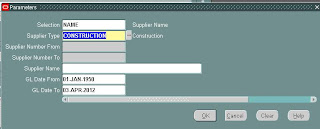Requirement – It is very common that business request to share concurrent program output file on every run.
Resolution – There are multiple options available to notify the output via email. Some of those are as below -
- - PL/SQL program unit to send the output file
- - Unix commands to send the output file
- - Email bursting concepts, if it is XML publisher report
Each program requires, additional effort/custom programs to achieve the emailing feature. In this post we shall learn the options already available in system. Which need small configuration change and CP will send the o/p as email.
Steps :-
1) Configuration Change – 2 profile needs to be set.
· FND: SMTP Host >> This to store the smtp server host details
· FND: SMTP Host >> This to store the smtp server port details
2) While submitting the CP, click the Delivery Opts (B)
3) Go to Email tab
4) Provide the To/From email address and Subject line, then press OK (B)
5) Submit/Schedule the program
Email bursting should be better approach, if we are working with XML publisher report.
Program will send the output file to specified email address. Program log file can be referenced in case any issue occurred.












